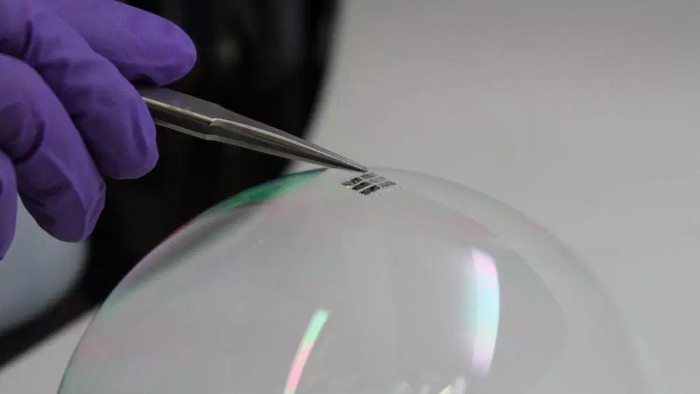Solar cells are as light as soap bubbles
US scientists invented ultra-thin and ultra-light photovoltaic batteries that can be placed on top of soap bubbles without breaking them.
In the study published in Organic Electronics, the scientists said the key to creating a new battery is to combine battery production, chemical catalysts and protective coatings in the same process."The battery is so light that you don't even know its existence on clothes or notebooks," Science Alert quoted Vladimir Bulović, a researcher at the Massachusetts Institute of Technology.
One benefit of combining solar cells and chemical catalysts is to protect against dust and pollution . The team used a flexible polymer called parylene as a chemical catalyst and coating, while organic DBP (dibutyl phthalate) was used to create a basic light absorption layer.

Solar cells, made by researchers at Massachusetts Institute of Technology, can be placed on soap bubbles.(Photo: MIT).
Unlike conventional solar cell production methods, the new process takes place in a vacuum chamber at room temperature without the use of soluble solutions or other chemicals. The research team used the vapor deposition technique, in which temperature, pressure, and chemical reaction produce a very thin coating on a specific material, to simultaneously produce solar cells and catalysts.
The researchers say this technique makes a very important breakthrough. As a result, ultra-thin and flexible panels, only one-fifth as thick as a human hair and equal to 1/1000 of the current glass battery (about two micrometers), can still convert sunlight into electricity. effectively. "If you breathe too hard, you can blow it away," said Joel Jean, a member of the research team.
According to the inventors, the new method of manufacturing puts solar cells on materials such as cloth and paper. Panels of this type are also useful in space or on high altitudes, where mass elements are important. However, the new type of solar cell needs several more years to complete before mass production.
- The soap is sufficiently colored in red and purple blue, why is it only white?
- The color of 'illusion' comes from the soap bubble
- Why can soap bubbles explode?
- Illusion amazingly from soap bubbles
- Video: The reason soap bubbles don't break when poked by hand
- Transmitting photos and flavors through soap bubbles
- Strange solar cells get energy from bacteria
- Soap 'magnet' oil spill cleanup
- The bubble froze in the sunlight
- Solar cells absorb 99.7% of light
- What's so hot in the bubble bubble?
- Huge bubbles in the universe
 Daily use inventions come from universities
Daily use inventions come from universities Special weight loss device helps prevent appetite
Special weight loss device helps prevent appetite 8 inventors were killed by their own inventions
8 inventors were killed by their own inventions Iran invented a motor car powered by water
Iran invented a motor car powered by water